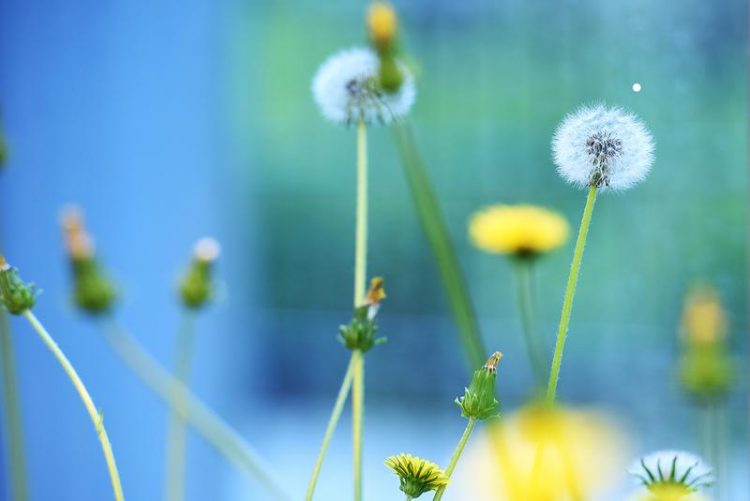Rubber from dandelions / Scientists identify key components in the formation of rubber

From dandelions a desirable product can be extracted: rubber. WWU/Peter Grewer
Dandelions are robust and undemanding plants – from which a desirable product can be extracted: rubber. This is why dandelions have increasingly become the focus of attention of the rubber-producing industry. But how is rubber, contained in the plant’s white milky fluid, actually formed?
There has not been any complete answer to this question yet, but a team headed by Münster University and the Fraunhofer Institute for Molecular Biology and Applied Ecology IME (Münster branch), has now identified proteins which play a key role in the production of rubber in the plant.
The milky fluid containing the rubber is produced in special cells in the dandelion. What is responsible for the formation – the biosynthesis – of the rubber is a protein complex located on the surface of so-called rubber particles. These globular particles are filled with polyisoprene, the main component of rubber, and are surrounded by a protective coating.
As the researchers have been able to demonstrate, using the example of Russian dandelion, there is one special protein (a so-called rubber transferase activator) which plays a key role. If the formation of the protein is prevented – in other words, if it is non-existent in the plant – then no rubber is formed. The scientists assume that the protein is necessary for the formation of the rubber-producing protein complex.
Their results have been published in the current online issue of the specialist journal “Nature Plants”. Scientists from Munich Technical University and from York, in England, were also involved in the work. A second study, which was likewise carried out with substantial input from researchers from IME and Münster University, identifies a further important protein which plays a key role in the formation of the long polyisoprene chains. These so-called polymers give the rubber its typical properties – its elasticity and resilience.
“Dandelions have become well-known recently in particular as a result of applied research,” explains head of research Dr. Christian Schulze Gronover (IME, Münster branch). “Now we are pleased to have some news again from the field of basic research: we have been able to identify no fewer than two key components of rubber biosynthesis.”
It has not so far been possible to manufacture natural rubber by biotechnological means. But the possibility has been brought a step closer, say the researchers, as a result of the identification of key components in rubber synthesis. Dandelion plants which produce no rubber could also in future be used in laboratory experiments in order to find out what the role of rubber in the plants is. According to one idea under discussion, for example, it provides protection against pathogenic agents.
As Dr. Dirk Prüfer, Professor of the Biotechnology of Plants at Münster University and head of the Functional and Applied Genomics department at the IME in Münster, points out: “We were only able to achieve these research results through effective collaboration between IME and Münster University – in other words, through the intelligent linking of applications-oriented and basic research. We hope to be able to continue to expand on this model for success.”
Original publications:
Janina Epping, Nicole van Deenen, Eva Niephaus, Anna Stolze, Julia Fricke, Claudia Huber, Wolfgang Eisenreich, Richard M. Twyman, Dirk Prüfer and Christian Schulze Gronover (2015): A rubber transferase activator is necessary for natural rubber biosynthesis in dandelion. Nature Plants, Advance Online Publication; DOI: 10.1038/nplants.2015.48
Natalie Laibach, Andrea Hillebrand, Richard M. Twyman, Dirk Prüfer and Christian Schulze Gronover (2015): Identification of a Taraxacum brevicorniculatum rubber elongation factor protein that is localized on rubber particles and promotes rubber biosynthesis. The Plant Journal, Advance Online Publication; DOI: 10.1111/tpj.12836
This is a concerted press release from Münster University and Fraunhofer Institute for Molecular Biology and Applied Ecology IME. At IME, please contact Sabine Dzuck (phone: +49 241 6085-13354; mobile: +49 173 304 5723; mail: sabine.dzuck@ime.fraunhofer.de)
Media Contact
More Information:
http://www.uni-muenster.de/All latest news from the category: Life Sciences and Chemistry
Articles and reports from the Life Sciences and chemistry area deal with applied and basic research into modern biology, chemistry and human medicine.
Valuable information can be found on a range of life sciences fields including bacteriology, biochemistry, bionics, bioinformatics, biophysics, biotechnology, genetics, geobotany, human biology, marine biology, microbiology, molecular biology, cellular biology, zoology, bioinorganic chemistry, microchemistry and environmental chemistry.
Newest articles

A ‘language’ for ML models to predict nanopore properties
A large number of 2D materials like graphene can have nanopores – small holes formed by missing atoms through which foreign substances can pass. The properties of these nanopores dictate many…

Clinically validated, wearable ultrasound patch
… for continuous blood pressure monitoring. A team of researchers at the University of California San Diego has developed a new and improved wearable ultrasound patch for continuous and noninvasive…

A new puzzle piece for string theory research
Dr. Ksenia Fedosova from the Cluster of Excellence Mathematics Münster, along with an international research team, has proven a conjecture in string theory that physicists had proposed regarding certain equations….



